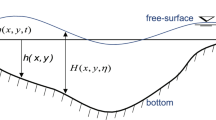Abstract
The surface evolver (SE) algorithm is a valued numerical tool for computations of complex equilibrium interfacial phenomena. In this work, an iterative procedure is implemented such that SE can be employed to predict steady-state flows along capillary channels of arbitrary cross-section. As a demonstration, a one-dimensional stream filament flow model is solved that approximates the pressure changes inside the channel. Despite its simplicity, the precision, stability, and speed of the method affirm it as an efficient and unique design tool for a variety of capillary flow problems. The procedure is ideally suited for slender column flows such as open wedge channel flows, several of which are validated herein via parabolic flight and drop tower experiments.
Similar content being viewed by others
References
Brakke K.A.: The surface evolver. Exp. Math. 1, 141–165 (1992)
Brakke, K.A.: Surface Evolver Manual. Susquehanna University, 2.26a (2005)
Collicott S.H.: Example impact of nonuniform acceleration fields on liquids in spacecraft. J. Spacecr. Rockets 44, 725–727 (2007)
Walkley M.A., Gaskell P.H., Jimack P.K., Kelmanson M.A., Summers J.L.: Finite element simulation of three-dimensional free-surface flow problems. J. Sci. Comput. 24, 147–162 (2005)
Scholle M., Aksel N.: An exact solution of visco-capillary flow in an inclined channel. ZAMP 52, 749–769 (2001)
Ayyaswamy P.S., Catton I., Edwards D.K.: Capillary flow in triangular grooves. J. Appl. Mech. 4, 332–336 (1974)
Matlab. Partial differential equation toolbox. The MathWorks Inc., 7.1.0.246(R16) (2005)
Weislogel M.M., Lichter S.: Capillary flow in an interior corner. J. Fluid Mech. 373, 349–378 (1998)
Jaekle, D.E.: Propellant management device conceptual design and analysis: Vanes. In: AIAA/SAE/ASME/ASEE 27th Joint Propulsion Conference, number AIAA 91-2172, pp. 1–13, Sacramento, CA, June (1991)
Rosendahl U., Ohlhoff A., Dreyer M.E.: Choked flows in open capillary channels: theory, experiment and computations. J. Fluid Mech. 518, 187–214 (2004)
Haake D., Rosendahl U., Ohlhoff A., Dreyer M.E.: Flow rate limitation in open capillary channel flows. Ann. NY Acad. Sci. 1077, 443–458 (2006)
Author information
Authors and Affiliations
Corresponding author
Additional information
Dedicated to Professor Wilhelm Schneider on the occasion of his 70th birthday
Rights and permissions
About this article
Cite this article
Klatte, J., Haake, D., Weislogel, M.M. et al. A fast numerical procedure for steady capillary flow in open channels. Acta Mech 201, 269–276 (2008). https://doi.org/10.1007/s00707-008-0063-1
Received:
Revised:
Published:
Issue Date:
DOI: https://doi.org/10.1007/s00707-008-0063-1




